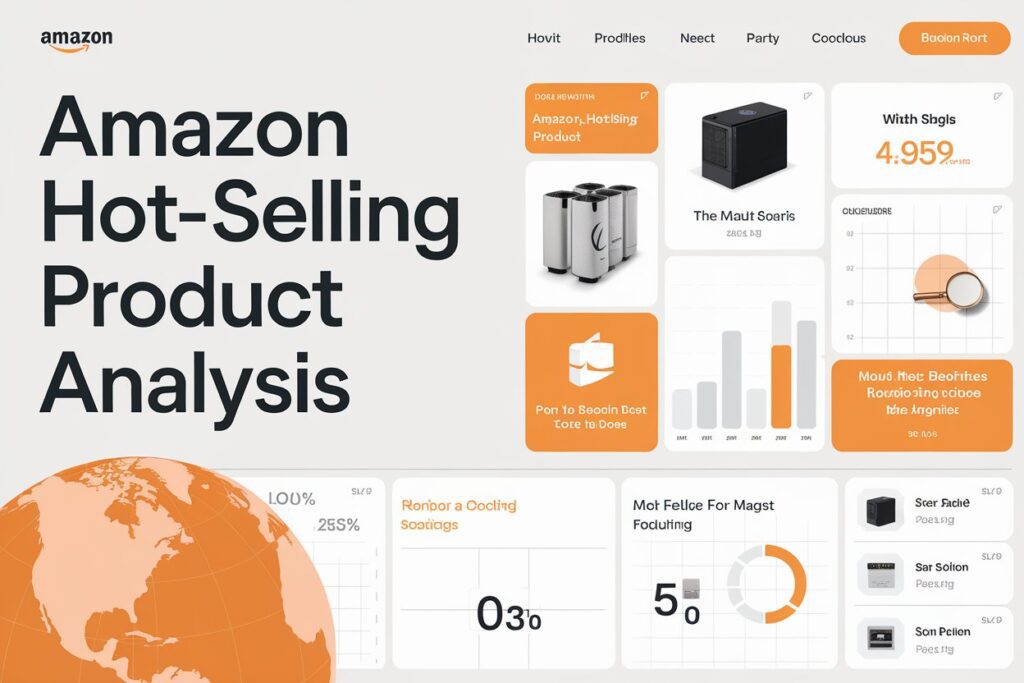1. Introduction: Why Must We Study Hot-Selling Products on Amazon?
“How can we strike gold with the products we choose to sell?”
“Why do others make a fortune while my listings remain unnoticed?”
“How can we spot an emerging category early and get ahead of the competition?”
In many ways, Amazon hot-selling product analysis is like the timeless “turning stones into gold” magic for the cross-border e-commerce arena. Sellers who can decode market demand, accurately gauge competitive dynamics, and keep their finger on consumer preferences often see their products turn into bestsellers. And the driving force behind all of this is in-depth data mining and rational judgment.
The crucial step here is data collection that is both precise and up-to-date. With the market evolving so quickly, relying on outdated weekly or monthly reports for your product decisions almost guarantees you’ll miss out on profitable opportunities.
2. Why Analyze Amazon Hot-Selling Products?
- Reveal Market Demand
You need to know which categories are on fire, which product features buyers value most, and which price ranges are hot. These clues can be found by investigating the sales volumes, reviews, and keywords of top-selling products. - Understand User Preferences
Looking at the distribution of reviews (especially star ratings) and Q&As on product detail pages helps you grasp consumers’ real pain points, allowing you to optimize your products or highlight key features. - Learn from Success Stories
Study how certain bestsellers soared to the top. Did they leverage off-Amazon advertising? Did they optimize their listings meticulously? Observing their success strategies can set you on a similar path. - Discover Potential Blue Oceans
A product might be showing signs of popularity before the market is oversaturated. Getting in early could help you gain a head start. Meanwhile, once “mass-market bestsellers” become too crowded, there could be new and lesser-known product trends on the rise. - Reduce Product Selection Risks
Investigating failed products or unsold inventory is equally vital. Why did they flop? Was the price point too high? Was the market monopolized? Did the product lack unique features? Data can answer these questions and steer you away from pitfalls.
3. Core Dimensions of Amazon Hot-Selling Product Analysis
- Product Itself
- Category & Function: Zoom in on a product’s material, design, and functionalities within its broader category.
- Price & Profit: Strike a careful balance between offering competitive pricing and ensuring sufficient margins.
- Reviews & Ratings: Customer feedback is the most direct window into actual user experiences.
- Listing Quality: The effectiveness of your title, images, keywords, and bullet points significantly influences click-through and conversion rates.
- Market Performance
- BSR Fluctuations: Watching the shifts in Best Sellers Rank (BSR) helps predict sales trends.
- Sales and Growth Rate: Sales figures indicate market size; growth rate points to future potential.
- Keyword Ranking & Search Volume: Determines how often customers see your listing in top results.
- Competitors
- Number & Strength: Is the market dominated by a few major players, or is it scattered among many smaller sellers?
- Product & Pricing Strategy: Differentiation is key for smaller sellers challenging the big ones.
- Marketing & Promotion: Observing your competitors’ advertising channels and promotional tactics can offer valuable insights.
- Market Trends
- Seasonality: Some products thrive in certain seasons, so align your stock and ad spend with these peaks.
- Popular Fads: If you catch the next big wave (e.g., a trendy design or a buzzworthy technology), your product may skyrocket.
- Shifts in Consumer Preferences: Tastes and expectations can change quickly. Stay alert and adjust your listings accordingly.
4. Methods and Tools for Amazon Hot-Selling Product Analysis
- Manual Analysis
- Browsing Amazon Lists: Best Sellers, New Releases, and Movers & Shakers are direct routes to discovering hot categories.
- Keyword Searches: Check search suggestions, search results, and Sponsored Ads to gauge competition levels.
- Product Detail Pages: Dig into review sections and Q&As to find potential improvements or unique selling points.
- Social Media Channels: Tiktok or Instagram trends can often hint at potential Amazon bestsellers.
- Tool-Assisted Analysis
- Jungle Scout / Helium 10 / MerchantWords / Keepa: Great for keyword research, competitor tracking, and trend forecasting.
- Pangolin Amazon Data Pilot:
- Enables cross-page data extraction to quickly generate operational sheets;
- Intuitive configuration requiring only 2–3 steps to filter down to hot-selling lists or target keywords;
- Straightforward data acquisition logic without cumbersome integrations.
- Pangolin Amazon Data API / Amazon Scrape API:
- Designed for large-scale, deeper data needs (e.g., for large sellers or SaaS providers). With these APIs, you can pull real-time Amazon front-end raw data or pre-parsed data;
- Customizable fields, mobile Sponsored Ad spots, and more advanced capabilities let you adapt smoothly to a wide range of operational requirements.
Choosing the right tool mix according to your business scale and requirements can save time, minimize costs, and boost your productivity.
5. Steps and Workflow for Amazon Hot-Selling Product Analysis
- Define Your Analysis Goals
Clarify the type of product or category you want to explore, your budget, and technical capacity. Are you trying to break into a crowded segment or discover a new niche? - Data Collection
Use Amazon’s public lists or tools like Pangolin Data Pilot, Jungle Scout, etc. to compile essential information such as sales estimates, reviews, and rankings. - Data Analysis
Chart sales trends, compare keyword search volume, and examine competitor pricing and product features. You can also deploy real-time Scrape API to collect the latest page data for in-depth scrutiny. - Draw Conclusions
Decide whether the market is oversaturated, whether your cost and profit margin can stand out, and if you have a unique angle or competitive edge. - Develop a Product Selection Strategy
- If feasible, proceed with product sourcing, create optimized listings, and plan your advertising campaigns;
- If the risks seem high or profit margins are weak, it may be better to pivot or explore another segment.
6. Amazon Hot-Selling Product Analysis Case Study
Take “yoga mats” as an example: many sellers sense the boom in fitness and mindfulness segments, but worry about stiff competition and narrow profit margins. Here’s how you might proceed:
- Goal
Aim to position mid-range, eco-friendly yoga mats with standout functionality and material. - Data Collection
- Use Pangolin Data Pilot to configure columns: core keywords, BSR, price, review counts, and ASIN;
- In just two or three steps, you can capture the yoga mat data from best-selling lists and generate comparison tables.
- Analysis
- Highly competitive space, but eco-friendly products with strong reviews are on a rapid rise;
- Price ranges between $18–$25 seem most attractive;
- Keyword searches for “Eco-friendly Yoga Mat” are climbing steadily.
- Conclusion
Entering a niche focused on eco-friendly materials seems viable. - Strategy
- Source quality materials that highlight “low odor” and “biodegradable” aspects;
- Emphasize keywords like “Eco-friendly,” “Non-Slip,” “Thick Cushion” in your listing;
- Continuously track competitor listings via Scrape API for new reviews or product updates to remain agile.
7. Conclusion and Outlook
Analyzing hot-selling Amazon products is crucial to discovering “gems” in a vast ocean and is an essential component for success in the seller’s journey. By collecting and comparing market data, you can uncover unfulfilled demands, anticipate emerging trends, and avoid product flops long before they impact your bottom line.
- Comprehensive Data Coverage—spanning product details, market conditions, competitors, and overall trends—ensures robust analysis outcomes;
- Tailored Tool Selection—whether it’s Pangolin Amazon Data Pilot, Data API, or Scrape API—enables efficient, direct data acquisition;
- Continual Optimization—pivot swiftly in response to market changes to prevent costly missteps.
As the e-commerce landscape evolves, competition intensifies. Data-driven product research and personalized insights will be your winning edges. May you seize opportunities, navigate storms, and transform your next listing into a major success story on Amazon!






